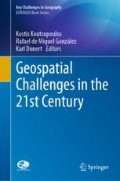Abstract
This research deals with the analysis of cultural heritage through innovative technologies and presents, in detail, a project which proved fully in line with the “smart city” model, in specie created for the promotion of the old neighborhoods downtown Salerno. The initiative, named “Salerno in Particular. Cultural Heritage and Innovation”, raised from the creativity of several students in the University of Salerno, who—within institutional cooperation—developed a cultural alternative to the extant ones, focused on the systematization of a wide range of knowledge and skills, both humanistic and scientific. Through a wide-ranging performance of activities and events—carried out in different and prestigious venues throughout the city—the historic district’s downtown Salerno (a geographical context characterized by a distributed presence of historical, artistic, and archeological relics) have been interpreted and proposed so to retrace the past with an eye to modernity. From a methodological point of view, the named actions have greatly benefited from the geographic-based contribution; in particular, they have allowed the deepening of aspects related to localization and contextualization of cultural heritage and made possible the elaboration of detailed maps (even geo-referenced and interactive, independently proposed, and others) as a starting point for the various involvements of the project).
Access this chapter
Tax calculation will be finalised at checkout
Purchases are for personal use only
Notes
- 1.
Virtual tours recreate virtual spaces within which the user can navigate between different parking points, observing 360°, interacting with the environment, activating points of depth with tabs with textual and multimedia content.
- 2.
Increased reality allows you to read additional information about the scene, using a QR code that initiates HTML tabs, movies, and audio files.
- 3.
Dynamic sites, such as social networks, allow continuous interaction from commented or uploaded users.
- 4.
Italian acronym for Distretto ad Alta TecnologiA per i BENi Culturali, i.e. High Technology Consortium for Cultural Heritage, private Company which uses modern technologies applied to the cultural heritages.It is a Consortium where the Universities of Naples Federico II and Salerno converge, the CNR, Small and Medium Enterprise Research Entities, created to develop a strategic programming action on cultural assets, Environmental heritage and tourism.
- 5.
Among which Luci d’Artista, Linea d’Ombra, Literature Festival, and Premio Charlot.
- 6.
Actions funded by the Urban and Urban II Initiatives.
- 7.
- 8.
Digital georeferenced orthophotos of Campania (orthophotos dated 2004 on a scale of 1:5000 and dated 2011 on a scale of 1:10,000); topographic map OSM (OpenStreetMaps); open source topographic maps available online.
- 9.
“Hippocratica Civitas” (Latin for “Hippocratic Town”) is the motto on Salerno’s Coat of Arms.
- 10.
The use of virtual reconstructions is presented through multi-platform and multi-device cooperative activities that allow groups of users to navigate within the same reconstructed environment, using a combination of immersive reality (3d viewers, Oculus Rift), 3d reality (With autostereoscopic screens) and collaborative interaction through appropriate sensor (Kinect).
- 11.
The TUIU is a logical scaffolding of the information system, defined by the space-time dimension, in which cultural, ancestral, topographic, archaeological, or archaeological, cultural, environmental, and tourist information can be combined.
- 12.
The TUIU spatial contiguity is used for EU detection.
- 13.
The initiative consists of the installation of luminous art works, created by internationally renowned artists, scattered throughout the main streets and in the most attractive corners of the Historic Center.
- 14.
Per ciascuna struttura, schede contenenti la denominazione dell’attività, le fasce orarie di apertura e chiusura, i giorni di chiusura, ma anche i recapiti telefonici, gli indirizzi e-mail e web site, nonché il numero di tavoli o di stanze, a seconda che si trattasse di attività di ristorazione o ricettiva.
References
Bonacini E (2011) Nuove tecnologie per la fruizione e valorizzazione del patrimonio culturale. Aracne, Roma
Campbell T (2012) Beyond smart city: how cities network, learn and innovate. Earthscan, New York
Caragliu A, Del Bo C, Nijkamp P (2011) Smart cities in Europe. J Urban Technol 18(2):65–82
Caroli M (2016) Gestione del patrimonio culturale e competitività del territorio. Una prospettiva reticolare per lo sviluppo di sistemi culturali generatori di valore. Franco Angeli, Milano
Cessari L (2016) Città, siti, musei: La ricerca scientifica e l’innovazione tecnologica per lo sviluppo del territorio. Gangemi, Roma
Dameri RP, Giovannacci L (2016) Smart city e Digital city. Strategie urbane a confront. Franco Angeli, Milano
Folger P (2010) Geospatial information and geographic information systems (GIS): current issues and future challenges. Biliogov, Columbus
Garofolo I, Conti C (2013) Accessibilità e valorizzazione dei beni culturali. Temi per la progettazione di luoghi e spazi per tutti. Franco Angeli, Milano
Giffinger R (2007) Smart cities. Ranking of European medium-sized cities. Centre of Regional Science, Vienna
Granelli A, Scanu M (eds) (2009) (Re)design del territorio. Design e nuove tecnologie per lo sviluppo economico dei beni culturali. Fondazione Valore Italia, Roma
Lee JG, Kang M (2015) Geospatial big data: challenges and opportunities. Big Data Res 2:74–81
Picon A (2015) Smart cities: a spatialised intelligence. Wiley, New Jersey
Robinson AC et al (2017) Geospatial big data and cartography: research challenges and opportunities for making maps that matter. Int J Cartography 3:32–60
Author information
Authors and Affiliations
Corresponding author
Editor information
Editors and Affiliations
Rights and permissions
Copyright information
© 2019 Springer Nature Switzerland AG
About this chapter
Cite this chapter
Amodio, T. (2019). Cultural Heritage and Collective Knowledge. In: Koutsopoulos, K., de Miguel González, R., Donert, K. (eds) Geospatial Challenges in the 21st Century. Key Challenges in Geography. Springer, Cham. https://doi.org/10.1007/978-3-030-04750-4_12
Download citation
DOI: https://doi.org/10.1007/978-3-030-04750-4_12
Published:
Publisher Name: Springer, Cham
Print ISBN: 978-3-030-04749-8
Online ISBN: 978-3-030-04750-4
eBook Packages: Earth and Environmental ScienceEarth and Environmental Science (R0)

